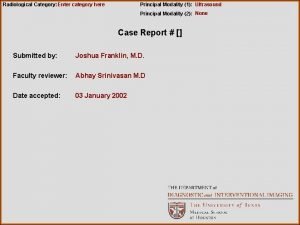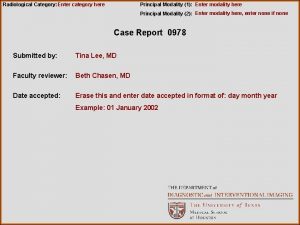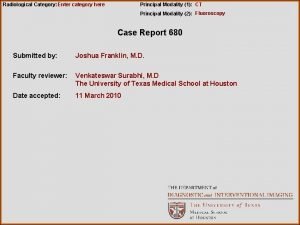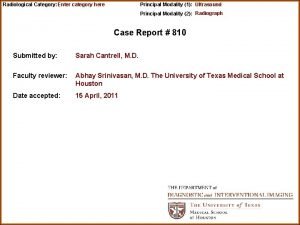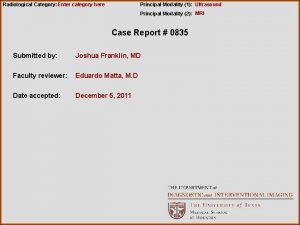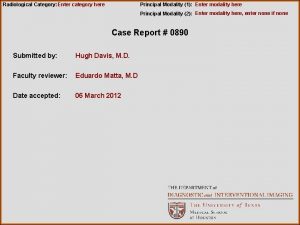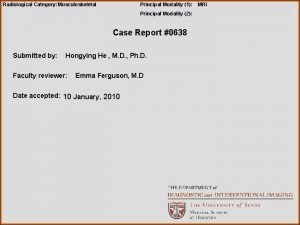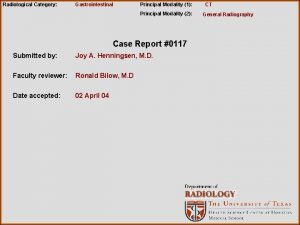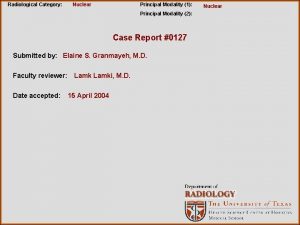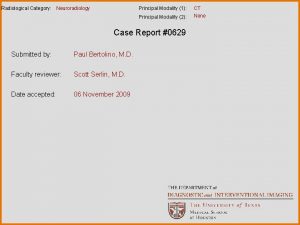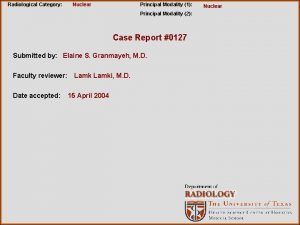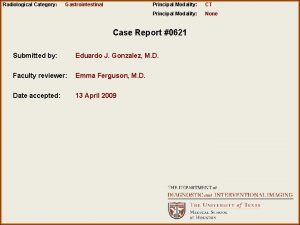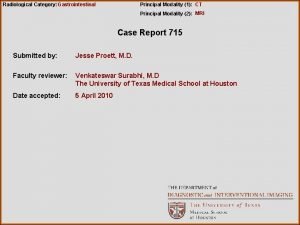Radiological Category Enter category here Principal Modality 1
















- Slides: 16

Radiological Category: Enter category here Principal Modality (1): Chest X ray Principal Modality (2): CT Case Report # 0832 Submitted by: Sudip Bhanderi, M. D. Faculty reviewer: Emma Ferguson, M. D Date accepted: 15 January 2012

Case History 40 year old AAM presents for sudden onset SOB and Chest pain for 3 -4 days, chronic cough for one month duration. Baseline chest x ray 1 year prior to presentation

Radiological Presentations Baseline chest x-ray taken 1 year prior to presentation

Radiological Presentations Chest x-ray at time of presentation

CT Chest with contrast at time of presentation

CT Chest with contrast at time of presentation

CT Chest with contrast at time of presentation

CT Chest with contrast at time of presentation

CT Chest with contrast at time of presentation

Test Your Diagnosis Which one of the following is your choice for the appropriate diagnosis? After your selection, go to next page. • Sarcoidosis • Lymphangitic spread of tumor with malignant lymphadenopathy

Findings and Differentials Findings: Chest x ray demonstrates development of new bilateral hilar masses and scattered small nodules in both lungs. CT Chest demonstrates multiple small nodules in a perilymphatic distribution with upper lobe predilection. Multifocal patchy ground glass airspace opacities involving mid and upper lungs. Bronchovascular interstitial thickening. Bilateral symmetric hilar and mediastinal adenopathy. Differentials: • Sarcoidosis • Lymphangitic spread of tumor with malignant lymphadenopathy

Discussion • • Sarcoidosis is the correct answer. The upper lobe pattern of perilymphatic nodules is typical of sarcoidosis. Sarcoidosis also presents with mid and upper lobe airspace opacities. Sarcoidosis typically presents with symmetric lymphadenopathy where as lymphangitic spread of tumor presents with asymmetric lymphadenopathy. The patients race and age also favor sarcoidosis. Lymphangitic spread of tumor with malignant lymphadenopathy is not favored as this patient does not have a know malignancy. Typically lymphangitic spread occurs with adenocarcinoma.

Discussion • • Sarcoidosis is a granulomatous disease which involves multiple systems. Most frequently involves lungs, lymph nodes, eyes and skin. There is high prevalence of the disease in African Americans. The disease afflicts young and middle aged adults. In chronic disease lymph nodes can demonstrate calcifications. Majority of patients are asymptomatic. If symptomatic may present with cough and shortness of breath. Sarcoidosis can have typical appearance on chest x rays and CT like this case. On Gallium-67 scan may show the “lambda” sign composed of uptake in paratracheal and bilateral hilar lymph nodes Gallium-67 uptake however is not specific and can occur with other inflammatory and infectious processes. FDG uptake may also be seen with sarcoidosis, however is not specific to the disease.

Discussion • • • Radiographic staging is as follows: – – – Stage 0: Normal chest radiograph Stage I: Lymphadenopathy without pulmonary disease Stage II: Lymphadenopathy with pulmonary disease Stage III: Pulmonary disease without lymphadenopathy Stage IV: Pulmonary fibrosis 1/3 rd of patients have spontaneous remission. 1/3 may have chronic progressive course. Treatment is with steroids for severe disease, progressive disease, extra pulmonary disease and for symptomatic patients. If no response to steroids then may be treated with immunosuppressive or cytotoxic agents.

Diagnosis Sarcoidosis

References Prabhakar H, Rabinowitz C, et al. Imaging Features of Sarcoidosis on MDCT, FDG PET, and PET/CT. AJR 2008; 190: S 1–S 6 Kazerooni E. A. High-Resolution CT of the Lungs. AJR 2001; 177: 501– 519 Munk P, Muller M. et al. Pulmonary Lymphangitic Carcinomatosis: CT and Pathologic Findings. Radiology 1988; 166: 705 -709 www. statdx. com
 Center for devices and radiological health
Center for devices and radiological health National radiological emergency preparedness conference
National radiological emergency preparedness conference Radiological dispersal device
Radiological dispersal device Tennessee division of radiological health
Tennessee division of radiological health Abandon all hope ye who enter here meaning
Abandon all hope ye who enter here meaning Let no one ignorant of geometry enter here
Let no one ignorant of geometry enter here Enter your text here
Enter your text here Pa erate
Pa erate Here i bow down here i bow down
Here i bow down here i bow down Induction field diathermy
Induction field diathermy Modality in statistics
Modality in statistics Tom arbuthnot
Tom arbuthnot Sodality vs modality
Sodality vs modality Cardinality and modality
Cardinality and modality Deontic and epistemic modality exercises
Deontic and epistemic modality exercises Modality erd
Modality erd Entity class in software engineering
Entity class in software engineering

















